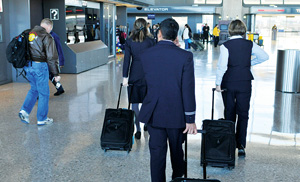Search News
For the Media
For media inquiries, call CWA Communications at 202-434-1168 or email comms@cwa-union.org. To read about CWA Members, Leadership or Industries, visit our About page.
Also in Spring 2012
- A day of stress and a long drive home
- Notice Regarding Union Security Agreements and Agency Fee Objections
- Safe-Patient-Handling Program Reduces Workers' Injuries
- In New Mexico, Patient Control is Challenge for Mental Health Workers
- "Prevention 360" Targets Workplace Injuries in Manufacturing
- Media Workers Put Their Safety on the Line
- Violence in the Workplace, New Manual
- Protecting AT&T Technicians from Street Violence
- Cal OSHA Report Contradicts UCLA on Lab Incident
- Working Together: Our Work Environment and How We Change It
- First-ever Criminal Charges Proceeding in UCLA Lab Fire
- Electrical Hazards: An Everyday Danger for Telecom Technicians
- Heat Stress, a Burning Issue for Outside Telecom Techs
- For N.J. Child Protective Services Workers, Violence Comes with the Job
- Strong New Workplace Violence Language At Kaleida Healthcare
Only in the Aircraft Cabin Can a "Workday" Equal 16 Hours
 Flight attendants, not yet covered by OSHA, often work up to 16 hours a day. |
Unlike most workers, flight attendants are excluded from coverage of some important federal laws. Their work environment, the aircraft cabin, is exempt from federal health and safety laws and falls under Federal Aviation Administration jurisdiction.
Only recently did flight attendants win the right to Family and Medical Leave Act protections, nearly 20 years after other workers.
Today, flight attendants are fighting for limits on the number of hours they can be required to work in a day. Fatigue is a critical problem for flight attendants which affects the safety of passengers and the aircraft.
Under FAA regulations, flight attendants can be scheduled for up to 14 hours a day, but often work longer hours since there are no strict duty time limits when delays occur. “Some days we fly eight legs, totaling 16 hours in a 24 hour day,” said AFA-CWA member Katherine Bruni, president of the AFA Horizon master executive council.
– Katherine Bruni, President AFA Horizon MEC
“You really get exhausted after a shift like that. Eight legs means eight boardings, eight takeoffs, eight landings and eight times to do cabin service,” she explained. “It’s crazy math that we only get paid for the time we spend working from boarding to landing."
Pilots are covered by stricker hour and rest rules, as are air traffic controllers, but Bruni said flight attendants have been excluded because the industry “does not consider us to be in a critical role because we are not at the controls.”
As flight attendant first responders, the health and safety of passengers depends on their being alert and calm during emergencies, during turbulence or when the aircraft has to be evacuated.
If they are fatigued, they can’t perform as well. Bruni says flight attendants begin to show signs of exhaustion after flying five legs or about 12 hours. “If you’re tired, you don’t always think clearly, and that can be a real danger to the aircraft.”
Before every takeoff, flight attendants perform vital checks, critical to the safety of the aircraft and passenger. At regional carriers, they also make a weight-balance count which they pass along to the pilot. Knowing how many passengers are in the aircraft, the seating distribution, and how many seats are not occupied is critical to a safe takeoff.
Bruni participated in a major fatigue study by the FAA in 2006 and hoped that it would quickly lead to sensible new limits on working hours. Unfortunately, the report didn’t result in any new duty hour regulations, and in fact, the FAA delayed the report’s release for over a year.
Recently, as a result of flight attendant mobilization and meetings with Capitol Hill lawmakers, new legislation was introduced to address flight attendant fatigue. The bill, the Airline First Responder Workplace Fairness Act, has strong bipartisan support, and flight attendants hope that fatigue issues finally will be addressed.